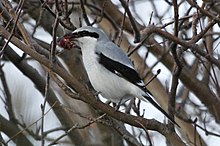Northern shrike
| Northern shrike | |
|---|---|

| |
| Scientific classification | |
| Domain: | Eukaryota |
| Kingdom: | Animalia |
| Phylum: | Chordata |
| Class: | Aves |
| Order: | Passeriformes |
| Family: | Laniidae |
| Genus: | Lanius |
| Species: | L. borealis
|
| Binomial name | |
| Lanius borealis Vieillot, 1808
| |
| Subspecies | |
|
6 sspp, see text | |

| |
The northern shrike (Lanius borealis) is a large songbird species in the shrike family (
Taxonomy
The northern shrike was
In North America, this and the related loggerhead shrike are commonly known as butcherbirds for their habit of impaling prey on thorns or spikes.[5] A folk name from Michigan is winter butcherbird.[6] The Vuntut Gwitchin First Nation people of Old Crow, Yukon call it Tzi kwut go katshi lyi.[7] As a passerine, or song bird, it has no talons. It has the hooked beak of a raptor.
A 2010 study of mitochondrial DNA found that the northern shrike was most closely related to the Iberian grey shrike (Lanius meridionalis), the steppe grey shrike (Lanius pallidirostris), and the two formed a clade along with the Chinese grey shrike and loggerhead shrike.[8]
Subspecies
East Eurasian group
- Lanius borealis sibiricus – eastern Siberia to northern Mongolia
- Browner above than excubitor, distinct but delicate banding below. Some white on primary bases only.
- Lanius borealis bianchii – Sakhalin and possibly southern Kuril Islands
- Smaller and paler than sibiricus, banding below pale and indistinct. Some white on primary bases only.
- Lanius borealis mollis – Russian Altai Mountains, north western Mongolia

- Browner than sibiricus above, banding below well-developed. Little white on primary bases.
- Lanius borealis funereus – Tian Shan and western China
- Large; quite dark and brownish, below bluish-grey with almost black banding. Little white on primary bases.
North American group
- Lanius borealis borealis – Hudson Bay region of Ontario and Quebec
- Similar to excubitor, but darker with faint barring below. Birds of America.
- Lanius borealis invictus – northern Alberta west to northern Alaska, perhaps also Chukchi Peninsula region in extreme north east Siberia
- Larger and paler than borealis, paralleling homeyeri compared to excubitor.
Description
The loggerhead shrike can be distinguished from the northern shrike by its smaller size, darker grey plumage and larger black face mask that covers the eye completely. It also has a shorter bill with less prominent hook. Their calls are similar.[9]
Measurements:[10]
- Length: 9.1–9.4 in (23–24 cm)
- Weight: 2.0–2.8 oz (57–79 g)
- Wingspan: 11.8–13.8 in (30–35 cm)
Distribution and habitat
Observations of wintering habitats in Idaho suggest suitable wintering territories are in demand, as northern shrikes that died in a particular area were quickly replaced.[11]
Feeding
Northern shrikes often sit on tall poles and branches surveying for food. They prey on arthropods such as spiders, beetles, bugs, and grasshoppers, and small vertebrates. Prey identified include passerine birds such as
References
- . Retrieved 19 November 2021.
- ^ Mayr, Ernst; Greenway, James C. Jr, eds. (1960). Check-list of Birds of the World. Vol. 9. Cambridge, Massachusetts: Museum of Comparative Zoology. p. 335.
- ^ Vieillot, Louis Pierre (1808). Histoire naturelle des oiseaux de l'Amérique Septentrionale (in French). Vol. 1. Paris: Desray. p. 80, plate 50.
- JSTOR 1363449.
- ^ JSTOR 1369596.
- JSTOR 453005.
- .
- PMID 19925872.
- ISBN 9780792253143.
- ^ "Northern Shrike Identification, All About Birds, Cornell Lab of Ornithology". www.allaboutbirds.org. Retrieved 2020-09-27.
- JSTOR 1369595.
- ISSN 0010-5422.
External links
- Northern shrike – Lanius borealis – USGS Patuxent Bird Identification InfoCenter
- Northern shrike species account – Cornell Lab of Ornithology

